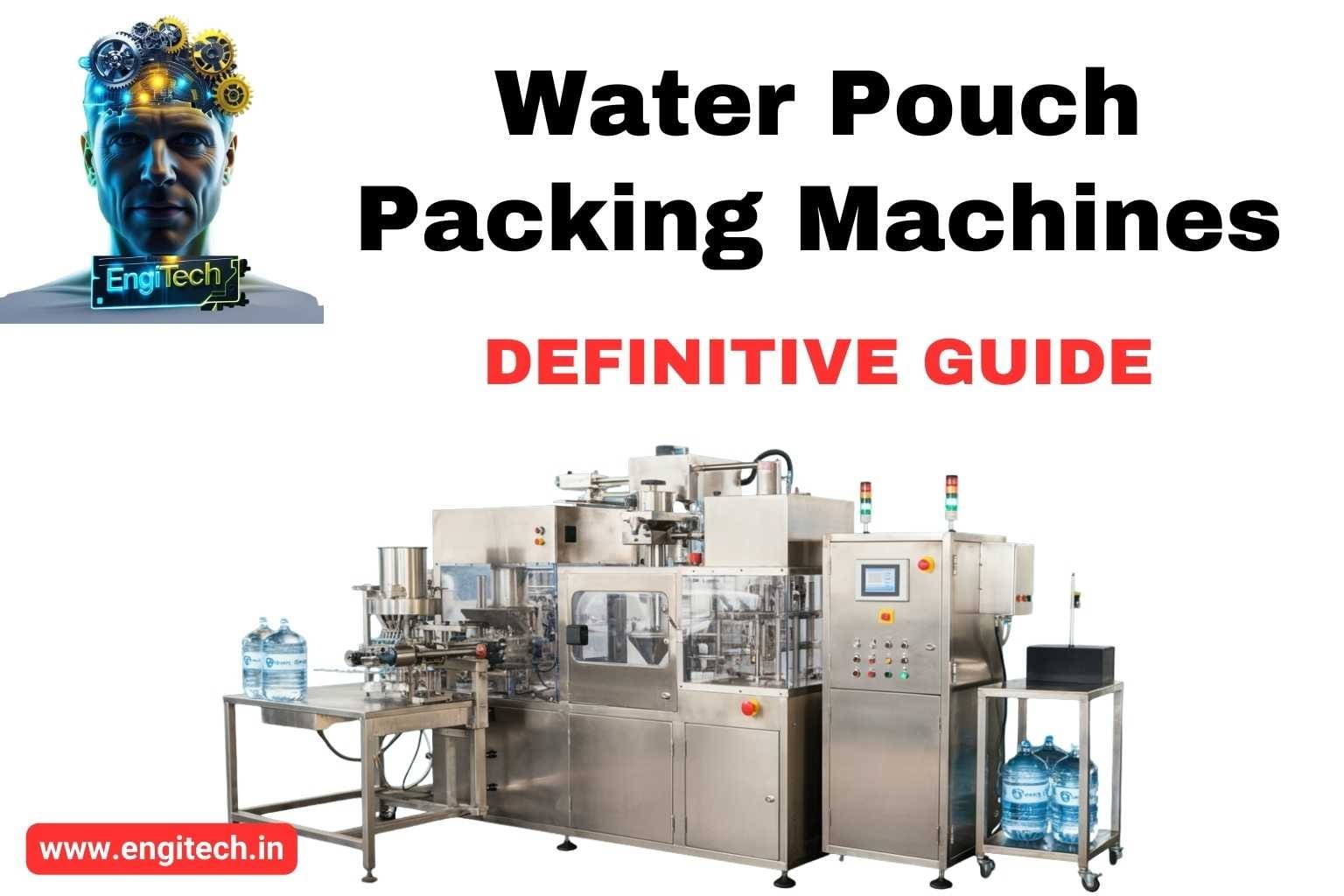Round Bottle Labeling Machine: The Definitive Guide to Efficient, Accurate, and High-Impact Packaging
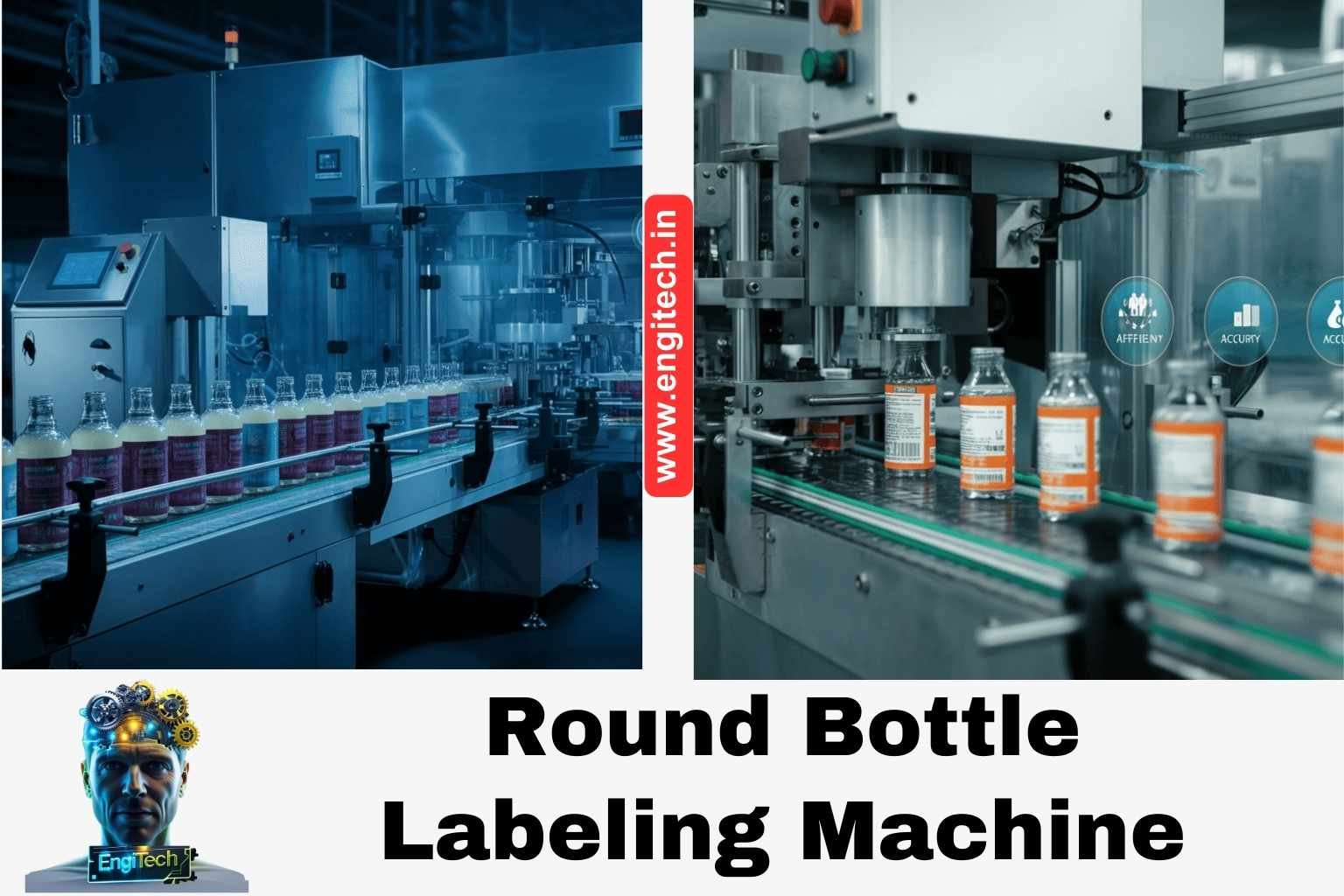
Imagine walking down a supermarket aisle where hundreds of products compete for your attention. From sparkling water to artisanal sauces, each bottle sports a label that aims to stand out. If you produce anything that comes in a round container—be it beverages, cosmetics, or household cleaners—you already know how important a label can be. It’s not just about aesthetics; your label conveys brand identity, vital product information, and even regulatory compliance details. That’s where a round bottle labeling machine steps in as a game-changer.
In the next several minutes, you’ll learn everything you need to know about round bottle labeling machines. We’ll explore different types of systems, dissect key components, dive into expert-backed best practices, and even troubleshoot common issues. Whether you’re an emerging craft brand or a well-established manufacturer seeking to optimize your packaging line, this guide offers insights you can put into action right away.
If you’re ready to level up your packaging game and meet customer expectations for quality and clarity—while also making your brand look phenomenal on the shelves—keep reading. This comprehensive guide will demystify the entire process, help you pick the perfect machine for your operations, and share expert tips to keep your production line humming efficiently.
Table of Contents
1. Understanding Round Bottle Labeling Machines
A round bottle labeling machine is a specialized piece of equipment designed to apply labels onto cylindrical or round-shaped containers consistently and accurately. Whether the bottle is made of glass, plastic, metal, or even composite materials, these machines ensure that each label is placed at the correct angle, with minimal wrinkles and perfect alignment. The technology behind these machines combines mechanical precision with sensor-based systems to detect bottles, position them, and apply labels seamlessly—often at remarkable speeds.
Key Highlights:
- Consistency: Eliminates human error, especially crucial for large volumes.
- Speed: Depending on the model, can label anywhere from a few dozen to several thousand bottles per hour.
- Scalability: Ideal for small businesses scaling up or large factories maintaining high throughput.
Pro Tip: Always match your machine’s capacity (labels per minute) to your current and projected production volumes. Oversizing or undersizing can affect both efficiency and ROI.
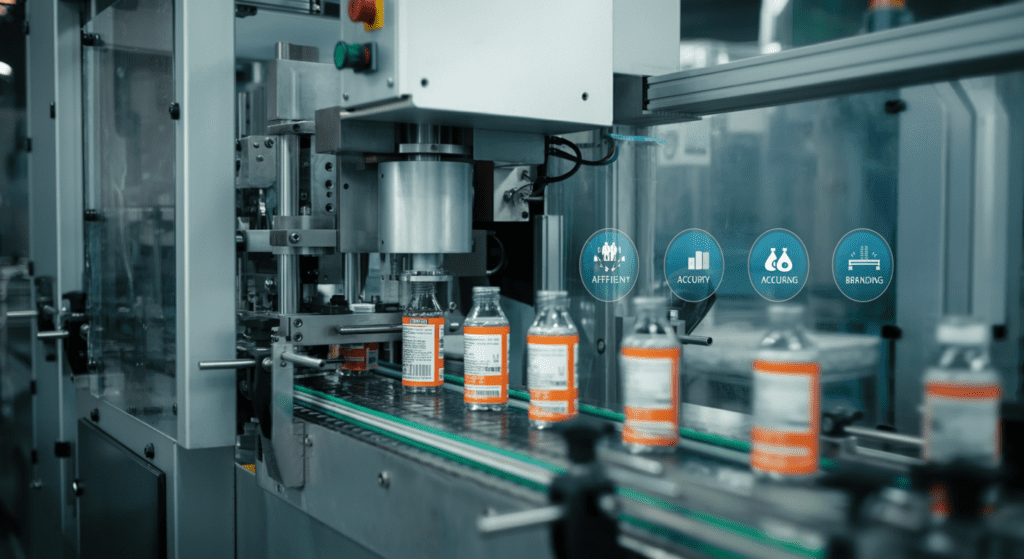
2. Why Labeling Matters: Branding, Compliance, and Beyond
Before we deep-dive into the mechanics, let’s talk about why labeling is so critical.
- Brand Identity: Your label represents your brand’s personality and values. High-resolution graphics, sharp fonts, and eye-catching designs foster brand recognition.
- Regulatory Compliance: Depending on your region and industry, your labels may need to include barcodes, lot codes, nutritional facts, or safety warnings.
- Consumer Transparency: Today’s consumers want to know exactly what they’re buying. Clear labels offering ingredient lists or usage instructions can build consumer trust.
- Shelf Appeal: In a crowded marketplace, a professionally labeled product stands out and encourages purchase decisions.
The Bottom Line:
A flawlessly positioned, vibrant, and error-free label can become a deal-maker for potential customers. Conversely, a poorly aligned or visually sloppy label can tarnish even the best product.
3. Types of Round Bottle Labeling Machines
Not all labeling machines are created equal. You’ll find three main categories: manual, semi-automatic, and fully automatic. Each serves a different production scale, budget range, and set of operational complexities.
3.1 Manual Round Bottle Labeling Machines
- What They Are: Hand-operated devices where the operator places the bottle and applies the label by rotating a handle or aligning the label by eye.
- Production Volume: Low to moderate, typically up to a few hundred bottles per day, depending on operator speed.
- Cost: Generally the least expensive option, perfect for startups and small craft businesses.
- Pros: Low initial investment, minimal setup, flexible for different bottle sizes.
- Cons: Operator fatigue, slower output, higher risk of alignment errors.
Real-World Example: A small artisan bakery that labels batches of specialty sauces a few times a week might use a manual system. They appreciate the hands-on approach and limited upfront cost.
3.2 Semi-Automatic Round Bottle Labeling Machines
- What They Are: A step up from manual systems, these machines incorporate motorized label dispensing but still require an operator to place or remove bottles.
- Production Volume: Medium-scale operations, ranging from hundreds to a couple of thousand bottles per day.
- Cost: More expensive than manual machines but significantly cheaper than full automation.
- Pros: Faster labeling speeds, better alignment consistency, moderate learning curve.
- Cons: Still requires manual intervention for loading or unloading.
Real-World Example: A mid-sized craft brewery producing several thousand bottles per day can use a semi-automatic machine. The label application is smoother, and the operator’s only task is to load the machine and remove labeled bottles.
3.3 Fully Automatic Round Bottle Labeling Machines
- What They Are: Highly sophisticated systems that integrate into a production line. Bottles move along a conveyor, pass through a sensor, and have labels automatically applied.
- Production Volume: Large-scale manufacturing where throughput can reach thousands—or even tens of thousands—of bottles per hour.
- Cost: Highest initial investment but offers the quickest payback for large-scale operations.
- Pros: Precision alignment, high-speed output, minimal labor, easy integration with other packaging processes.
- Cons: Requires more floor space, higher maintenance costs, and specialized technical knowledge.
Real-World Example: A multinational beverage company producing thousands of bottled sodas per hour relies on fully automatic labeling machines. This ensures lightning-fast production with near-zero mislabeling errors.
4. Key Components and Their Functions
Regardless of the machine’s level of automation, the following components play a central role in any round bottle labeling machine:
- Conveyor System (Fully Automatic Only): Moves bottles at a steady pace to ensure consistent labeling.
- Roller or Belt Drive: Rotates or stabilizes the bottle during label application.
- Sensor Array: Detects the presence of a bottle and signals the labeling mechanism to apply the label at the correct moment.
- Label Dispenser: Unwinds the label roll and positions the label for application.
- Peel Plate: Separates the label from its backing paper to make it “ready to stick.”
- Applicator: Physically presses the label against the bottle, often aided by air blasts or mechanical rollers.
- Control Panel: Lets you adjust label position, speed, and other operational parameters.
Why It Matters: Understanding these components can help you identify bottlenecks, troubleshoot mechanical issues, and communicate effectively with suppliers when you need replacement parts or upgrades.
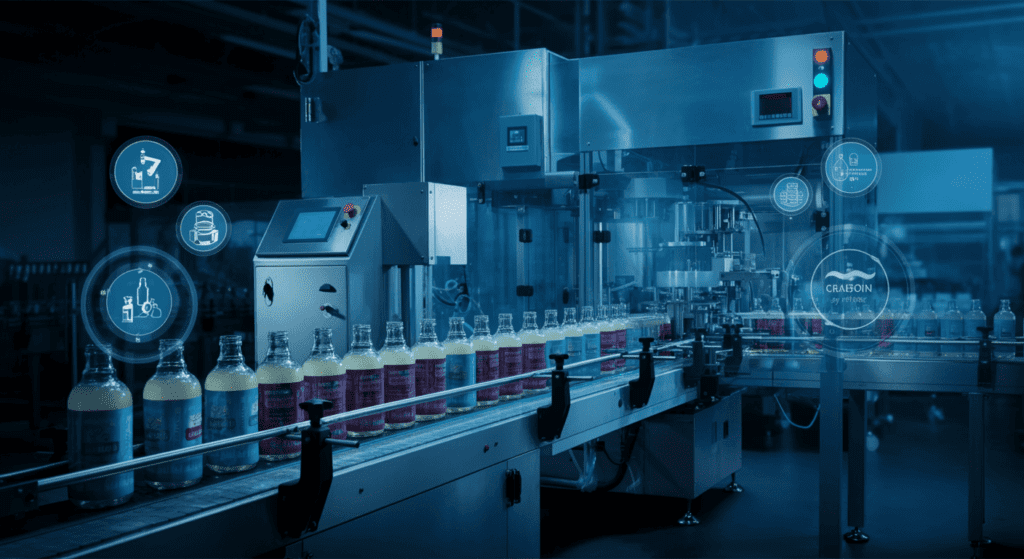
5. Step-by-Step Process of Round Bottle Labeling
Ever wonder exactly how a label goes from a spool of paper to a perfect wrap-around on a bottle? Here’s the simplified sequence:
- Bottle Infeed
- Bottles are placed on the machine’s conveyor or holder.
- Detection and Alignment
- Sensors pick up the presence of a bottle and position it correctly.
- Label Release
- The machine unwinds the label from the roll and peels it off the backing.
- Application
- The label meets the bottle surface, often with the help of a roller or tamp.
- Wrapping and Pressure
- Rollers or belts rotate the bottle to apply even pressure, ensuring the label adheres without bubbles or wrinkles.
- Inspection (Optional)
- Some advanced systems use machine vision to verify correct placement.
- Bottle Outfeed
- The labeled bottle moves on, either to packaging or to the next production stage.
Case in Point: High-end pharmaceutical lines often integrate cameras to confirm each label’s barcode is readable and properly placed, thereby ensuring regulatory compliance.
6. Selecting the Right Machine for Your Business
Choosing a round bottle labeling machine can feel overwhelming, especially if you’re new to automated packaging. Here are some decision-making factors to simplify your journey:
- Production Volume:
- Low: Manual or entry-level semi-automatic.
- Medium: Semi-automatic or low-range fully automatic.
- High: Fully automatic with high throughput capabilities.
- Budget Constraints:
- Don’t just look at the price tag—consider total cost of ownership (TCO), including maintenance, labor, and potential downtime.
- Bottle Variety:
- If you label multiple bottle sizes or materials, opt for a machine with adjustable guides and quick-change parts.
- Future Expansion:
- If you anticipate growth, invest in a machine that can scale or be upgraded with additional modules (e.g., wrap stations, date coders).
- Regulatory Requirements:
- Pharmacies and certain food/beverage lines might need integrated coding or inspection systems for barcodes and lot numbers.
Pro Tip: Request a demonstration or trial run with your specific bottles and labels before committing to a purchase. Manufacturers often offer sample testing to confirm proper fit and alignment.
7. Maintenance and Troubleshooting: Keeping Operations Smooth
Even the most robust round bottle labeling machine can suffer downtime without proper care. Here’s how to keep your system running at peak efficiency:
- Routine Cleaning
- Wipe down rollers, sensors, and label applicator pads daily. Residue from adhesives can build up and hamper performance.
- Scheduled Calibration
- Periodically calibrate sensors and check label release timing to maintain pinpoint accuracy.
- Lubrication
- Mechanical parts like gears and rollers should be lubricated according to the manufacturer’s specifications.
- Stock Proper Spare Parts
- Belts, rollers, and sensors can wear out. Keep spares on hand to minimize downtime.
- Troubleshooting Common Issues:
- Misalignment: Often due to a dirty sensor or incorrect bottle guide setup.
- Label Tearing: Caused by incorrect tension on the label roll or a misaligned peel plate.
- Wrinkling: Usually from insufficient pressure or poorly adjusted rollers.
- Skipping Bottles: Sensor might be failing to detect bottles correctly—clean or replace.
Expert Insight: Preventive maintenance is far less expensive than emergency repairs. Keep a logbook of maintenance tasks and schedule them before problems arise.
8. ROI and Cost Analysis
Investing in a round bottle labeling machine can be a significant expense, but the payoff can also be substantial. Let’s crunch the numbers:
- Initial Investment vs. Long-Term Savings:
- While manual machines cost a few hundred dollars, fully automatic systems can run tens of thousands (or more). In a large operation, labor savings and increased output can offset these costs within months.
- Labor Reduction:
- Automation decreases the need for large crews, reducing labor-related expenses like salaries, training, and potential for human error.
- Reduced Waste:
- Automatic and semi-automatic systems typically waste fewer labels and fewer products due to mislabeling errors.
- Efficiency Gains:
- Higher throughput means you can ramp up production without increasing floor space or staff significantly.
- Opportunity Costs:
- A slow or unreliable labeling process can hamper your entire production line, potentially losing time-to-market opportunities.
Financial Tip: Calculate your break-even point by dividing the total machine cost by projected monthly savings. Once you pass that break-even mark, the machine essentially pays for itself.
9. Industry Applications and Real-World Examples
The versatility of a round bottle labeling machine makes it a staple in multiple industries, each with unique demands and constraints.
9.1 Food and Beverage
Use Case: Think craft beer, artisanal sauces, cold-pressed juices, and bottled water. All rely on consistent branding and mandatory nutritional or ingredient labels.
- Requirements: Food-safe adhesives, clear or moisture-resistant labels for chilled products, barcode compliance for retail.
- Real-World Win: A kombucha startup scaled from a manual hand-labeling setup to a semi-automatic machine, increasing daily output from 200 bottles to over 1,000—without adding staff.
9.2 Pharmaceuticals
Use Case: Over-the-counter medications, dietary supplements, prescription drugs, and personal protective equipment solutions.
- Requirements: Compliance with stringent labeling regulations, inclusion of lot codes, expiration dates, tamper-evident seals.
- Real-World Win: A mid-sized pharmaceutical company introduced an integrated vision inspection system to verify barcodes and dosage instructions on each bottle. This drastically reduced returns and compliance errors.
9.3 Cosmetics and Personal Care
Use Case: Shampoo bottles, lotions, essential oils, and more.
- Requirements: Attractive, smudge-free labels that complement luxurious packaging. Often multiple label applications per bottle (front and back).
- Real-World Win: A natural skincare brand upgraded to a fully automatic round bottle labeling system to handle a variety of bottle diameters. The result: consistent labeling with minimal downtime when switching between product lines.
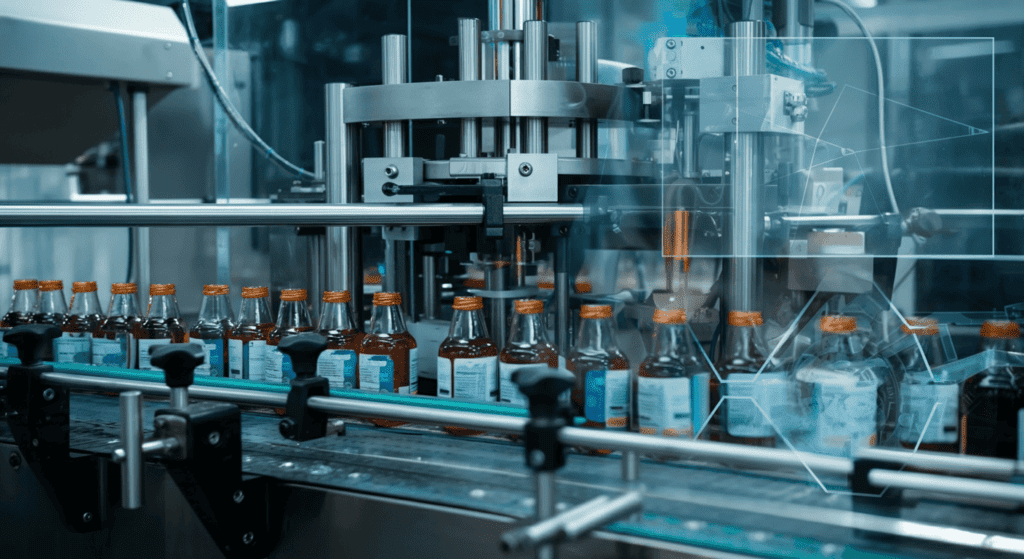
10. Expert Tips and Best Practices
Whether you’re operating a small cottage business or overseeing a high-speed production line, these tips can make all the difference:
- Optimize Label Quality
- Ensure your label material and adhesive suit the container and the environment. If bottles are refrigerated or exposed to moisture, choose weather-resistant labels.
- Test Runs
- Before a full production run, perform test labels to catch alignment, color, or adhesive issues early.
- Integrate Date Coding
- Many labeling machines can include a thermal transfer or inkjet coder to print expiration dates or lot numbers—vital for food, beverage, and pharma.
- Train Your Staff
- Even if the machine is fully automated, an informed operator can quickly spot potential problems, minimizing downtime.
- Monitor Production Metrics
- Track labeling accuracy, downtime incidents, and waste to continually refine your process. Simple software integrations can automate this data tracking.
- Upgrade Strategically
- If you see consistent growth and a possibility to expand your product line, investing in modular features like dual-label stations or integrated inspection can save future headaches.
FAQs about Round Bottle Labeling Machine
Below are some common questions asked by businesses considering a round bottle labeling machine:
Q1: Can one machine handle different bottle sizes and shapes?
Answer: Yes, most modern labeling machines offer adjustable guides and roller systems. However, extremely varying diameters or unique shapes (like oval or tapered bottles) might require specialized attachments or a different machine altogether.
Q2: What is the typical speed range for round bottle labeling machines?
Answer: Speeds vary widely. Manual machines depend on operator dexterity, while fully automatic systems can label thousands of bottles per hour. Semi-automatic models often range between 500 to 2,000 bottles per hour.
Q3: Are there specific label materials recommended for round bottles?
Answer: Common label materials include paper, polypropylene, and polyester. The choice depends on the bottle’s environment (hot, cold, wet) and industry requirements. Always test adhesion on your specific container material.
Q4: Do I need a separate machine for labeling both the front and back of a round bottle?
Answer: Many round bottle labeling machines can apply two labels (front and back) in a single pass, especially if they’re semi-automatic or fully automatic. Verify the specifications before purchase or look for a machine explicitly designed for multi-label applications.
Q5: How do I integrate a labeling machine into my existing production line?
Answer: Consider conveyor height, speed synchronization, and control systems. Many machines are designed to communicate with existing packaging line systems via PLCs (Programmable Logic Controllers). Professional installation and operator training can ensure a smooth integration.
Conclusion
A round bottle labeling machine is more than just an upgrade—it’s a pivotal investment that can supercharge your packaging efficiency, enhance brand image, and elevate your overall product quality. By choosing the right level of automation and paying close attention to maintenance, you’ll minimize errors, reduce waste, and boost your ROI. Today’s consumers demand clarity and professionalism in labeling, and an automated system ensures you meet those expectations while staying competitive in an ever-evolving marketplace.
Key Takeaways
- Match your machine type (manual, semi-automatic, fully automatic) to production volume and future growth.
- Regular maintenance, including cleaning and calibration, is crucial for long-term reliability.
- Invest in quality labels and adhesives suited to your bottles and storage conditions.
- Look for modular options that can expand with your business.
If you’re ready to transform your packaging line, now is the time to act. Research leading manufacturers, request demos, and consult with industry experts. For a more in-depth dive into packaging solutions, labeling regulations, or to explore additional automation options, feel free to check out our other resources on our website and join our newsletter for expert insights and the latest industry trends.
By making a strategic investment in a round bottle labeling machine, you can position your brand for success, drive consumer trust, and keep pace with industry leaders. So why wait? Start exploring your options today and watch your efficiency and brand reputation climb to new heights.
Stay Connected with EngiTech
EngiTech is your trusted source for in-depth knowledge on industrial mechanical engineering machines and technologies. Stay ahead with the latest innovations, expert insights, and practical guides designed to help you make informed decisions for your business and engineering needs. Join our growing community of professionals and industry leaders to stay updated and competitive in the ever-evolving world of industrial technology.


